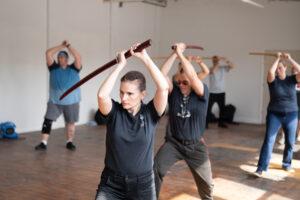
How and Why to Start Learning Sword Fighting
Introduction
Sword fighting is an ancient martial art that has captivated warriors and enthusiasts for centuries. While once essential for survival, modern sword fighting offers you a mix of historical appreciation, fitness benefits, and self-discipline. Whether you want to train for self-defense, sport, or theatrical performance, picking up a sword can be a rewarding experience.
Why Learn Sword Fighting?
Get the Physical Benefits
Sword fighting enhances your strength, agility, hand-eye coordination, and cardiovascular fitness. Training with a bokken or real sword provides you with a full-body workout, while also improving your flexibility and endurance. Don’t believe us? Try it yourself, at one of the Sword Experience events and then you will see what we are talking about.
Mental Benefits
Beyond the physical aspects, sword fighting sharpens the mind. When facing someone with a weapon you need to develop increased focus, patience, and mental resilience, which in turn, believe it or not, is an excellent way relieve stress.
Self-Defense and Practicality
Although modern self-defense mainly relies on hand-to-hand combat or firearms, understanding bladed weapon techniques can be translated to any item, like a broom handle, or stick, which will provide you with an extra layer of preparedness and confidence.
Cultural and Historical Appreciation
If you love pop culture you may also love the history of legendary warriors, such as samurai, knights, and fencing masters. Some of the many sword fighting styles to explore:
- European Styles: Fencing, HEMA (Historical European Martial Arts), longsword combat.
- Asian Styles: Kendo, Kenjutsu, Iaido, Chinese swordplay.
- Theatrical Sword Fighting: Designed for movies, TV, and stage performances.
Learning sword fighting gives you a first hand experience on the techniques and systems that made them survive battles and man to man combat.
Getting Started with Sword Fighting
Choosing the Right Sword
AT the Sword Experience, like in many sword fighting styles, you start with a wooden weapon. At SXP we hold all our sessions with bokkens, a safe way to learn footwork, distancing, strength of swing etc before progressing to live blades
Essential Gear and Safety Equipment
When using wood, a good mode of practice is to wear gloves, because the hands are usually the body parts that get struck first. The thousands who have participated in SXP events encountered no injury, with only a few incurring a slight bump on their fingers. For those of you who progress to steel, or if you are practicing body strikes, an extra layer of protection would include masks, and padding to prevent injuries.
Begin With Basic Stances and Footwork
Mastering stances like chudan-no-kamae, middle guard in katana training, or en garde in fencing, are crucial when facing an opponent. Plus learning the differences of advance, stepping, or replacement footwork, will help you enjoy the more complex sword movements as you advance.
Best Ways to Learn Sword Fighting
Attending SXP Events & Training Tours
The best way to learn is through hands-on experience. SXP Tours offer expert-led training in a dynamic environment, where you can practice techniques with experienced instructors for a more extended period of time. Our one day Elite events, or our Academy events, help you understand and enjoy the basics, but like anything, “Practice makes perfect”.
Finding a Local or Online Instructor
Joining a martial arts school or taking virtual lessons can accelerate your learning. The weekly or daily practice helps your mind and your body react to situations rather than think about the movements
Practicing at Home with Bokkens and Training Swords
The SXP Online Academy, or any other sword fighting online program, although we think we have you covered, since we not only give you daily drills with a bokken to improve muscle memory and technique, we include fitness with joint, tendon and muscle conditioning.
Don’t make these Beginner Mistakes
- Holding the sword incorrectly
- Ignoring footwork
- Overcommitting strikes without precision
- Skipping warm-ups and stretching
Recommended Training Tools
- Bokkens and training swords for safe practice.
- Books and video tutorials for theoretical learning.
- Protective gear to ensure safety during sparring.
Recommended Training Tools
Mastery of sword fighting requires dedication and consistent practice. It takes years to not only learn a discipline but to explore it. Most practitioners see noticeable improvement within a few months, while true mastery can take years through the constant exploration of techniques, or including ideas in your arsenal from different of styles. Adrian says the most he learned while sword fighting, was when he was teaching people. Watching the movement of others, helped him understand the difficulties or errors that we all make. So sometimes take time to watch, rather than do.
Recommended Training Tools
Whether you’re interested in sword fighting for fitness, self-defense, or historical appreciation, starting today can be an exciting and fulfilling journey. To accelerate your learning, consider joining an SXP Tour/Event or investing in a high-quality bokken from Sword Experience. The path of the sword awaits!
FAQs
1. Is sword fighting difficult to learn?
While challenging, beginners can quickly grasp the basics with proper training and consistent practice.
2. What is the safest way to start learning sword fighting?
Starting with a wooden bokken and learning under a qualified instructor is the safest approach.
3. Can I learn sword fighting at home?
Yes, but structured training through an event like an SXP Tour provides faster and safer progress.
4. How long does it take to become skilled at sword fighting?
Basic proficiency takes a few months, while mastery can take a lifetime.
5. What equipment do I need to start?
A bokken, protective gear, and a proper training space are essential for beginners.



Leave a Reply